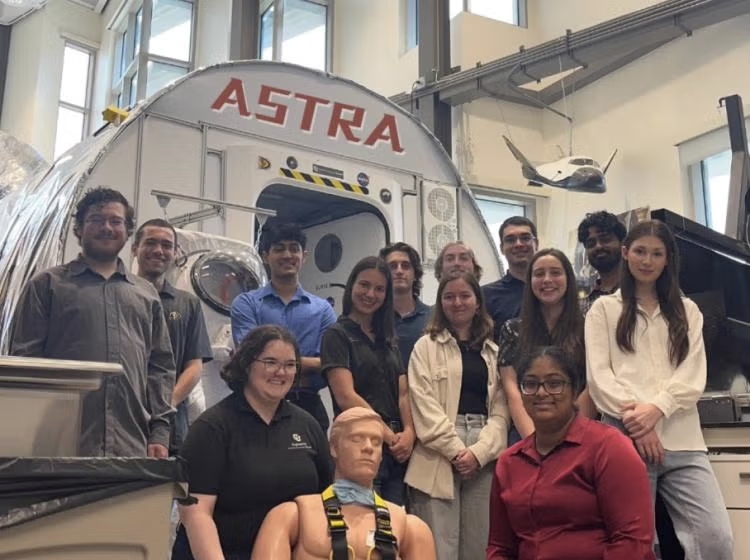Student-designed astronaut balance system wins aerospace competition

A team of 13 engineering seniors earned first place in a national aeronautics student paper competition for their capstone design project.
Team ASTRA (Astronaut Stability Training Response Apparatus) spent nine months analyzing, designing, and building a proof-of-concept reactive balance board training system to assist astronauts in maintaining their sense of position and movement while in space to improve recovery time when they return to Earth.
“It’s about being able to tell where you are in relation to your own body,” said Sweta Alla, the team’s project manager. “That’s knowing when to step, when to catch yourself. It tends to go away in microgravity. Our goal is to enhance that on Earth to help improve it in space.”
The team won the American Institute of Aeronautics and Astronautics (AIAA) Region V student paper competition, an annual event that brings together student design teams from 10 states and six Canadian provinces to showcase their capstone projects.
It was an exciting recognition that followed two semesters of effort.
“We did a lot of theoretical work, building out CAD models, cost benefit analyses, risk matrices, how the design would look and how we can build it to function,” Alla said. “The first few weeks were just sitting with the idea and design.”
The project design and build process included all of the ups and downs that are part of any engineering undertaking.
“We had a lot of setbacks and hurdles we had to get through, which strengthened our understanding of how engineering really works,” said Chloe Zentner, the team’s CFO. “A major issue was getting our motors. It was supposed to be two weeks for shipping, but it ended up being almost two months. That set a lot of our testing plans and timelines back.”
To complete the project, the team combined off-the-shelf and custom electronic components, requiring them to work in four unique programming languages: C#, C++, Python, and Dragon Ruby.
“We had to get all of the components to talk to each other, and the motors were supposed to come with software that was basically plug and play. They did not,” said Alia Feltes-DeYapp, systems engineering lead.
Their ultimate design was a structure a person could stand inside that actively monitors their center of balance and, based on movement, provides countervailing forces to approximate the experience of gravity on Earth. The project also incorporates an easy-to-understand gaming interface.
“It really was an amazing experience to get to do something for the entire year,” Feltes-DeYapp said. “We used our hands and built something from start to finish.”
As first place finishers at AIAA Region V, the team is qualified to compete in the upcoming AIAA International SciTech Forum and Exposition, slated for Jan. 2026

